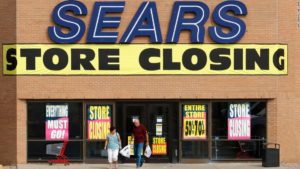
Source: CNN.com
Recent days have seen Sears in the headlines for all the wrong reasons. While the company has been in financial straits for some time, the pressure has been mounting and today comes reports that the company may avoid bankruptcy thanks to a last-minute bid from CEO Eddie Lampert’s investment company. Certain Sears creditors are expected to object to the deal whether it’s the best outcome of the company’s recent Chapter 11 bankruptcy filing.
It’s a complicated situation and one that brings up mixed emotions. As a consumer of a certain age, I remember dog-earing the pages in the Sears Wishbook for Santa, visiting the store for back to school clothes, working with my grandfather’s Craftsman Tools and spending my hard-earned babysitting money on a small, 13” black and white TV from the Sears electronics department.
But there’s another dimension complicating my feelings around Sears and their recent challenges: I used to work there.
I joined Sears Holdings Company, parent company to Sears, Kmart and (at the time) Land’s End, as a product manager. During my time there, I managed payment and post-order. My role covered essentially everything from the time a shopper entered their credit card and coupon details through shipping and delivery of items.
I can’t speak for everyone I worked with, but most of those on the team were energized by the vision of transforming Sears for the 21st century. But even back then there were challenges, many of which have been widely reported. Here are three of the lessons I learned from the experience.
1. Consistency Matters
With a huge number of stores and a robust operations center, Sears was an early pioneer in the omnichannel experience. The ability to order online and pick up from your car in designated parking spots, which is now widely advertised by several big-box discount retailers? I worked on that product for Sears – in 2010.
While a great idea in concept, and even an idea that was (arguably) ahead of its time, the buy-online-pick up-in-store idea kind of flopped. Why? The devil was in the details. For example, take coupons. Often the user saw a promotion online that they hadn’t applied towards their purchase because they didn’t know they could. The result? Disappointment.
In today’s hyperconnected world having an experience that’s streamlined, clearly communicated, familiar and complementary across the board is even more important. If you are coordinating experiences between various channels, whether in-person events, chapter communication, international outlets, social media or your website and online community, regularly do a quick review and ensure your messaging is consistent across the board. It can save you time and customer service headaches down the road.
2. Know Your Audience
Shortly before leaving Sears, I spent time with the customer service call center team. As the company focused on building out a massive online marketplace, many of the shoppers I spoke with found already found online shopping a challenging experience. They were calling to complain and taking their business elsewhere. And those were just the shoppers I spoke with.
We were building the business from the top down, but maybe it should have been from the bottom up. Take the time to talk to the constituents engaging with your organization. Understand their preferences and behaviors, acknowledge their concerns and use what you’ve heard to build an organization that meets their needs and exceeds their expectations. Your retention rate will thank you for it.
3. Stay Focused on What Matters
Sears sought to evolve their business by building a large online marketplace to rival Amazon. They partnered with small businesses and amassed a huge catalog of products. But in doing so, they lost sight of what made them successful. Popular, and profitable, brands like Craftsman and Kenmore got lost in the mix.
If you’re planning to expand your organization in 2019, look at the programs your constituents know and love. Do the new benefits that you want to introduce make sense? Will they build on your success or distract constituents from understanding and internalizing the value you provide?
Wrapping Up
With some time away from the ecommerce space, and from the outside looking in, I recognize what’s happening with Sears as an important example of how vulnerable an organization can become — no matter the size, brand or history. The nonprofit sector, with its lean resources and commitment to the invaluable work of social good, can’t risk exposure to the same risk. Learning from the past to secure the future can be a good place to start.
